- Self-healing performance of coated slag aggregates in wheat straw ash blended cement composites
Jun suk Lee, Abdul Qudoos, Atta Ur Rehman, Hong Gi Kim, Sadam Hussain Jakhrani and Jae-Suk Ryou*
Department of Civil Engineering, Hanyang University, Seoul, Korea
The cracks in the concrete structures permit the ingress of harmful ions which ultimately exacerbate the durability of the structures. In addition, the environmental concern of the cement production necessitates the utilization of pozzolanic materials. This study used wheat straw ash as cement replacement material. Sodium silicate impregnated in slag aggregate, an industrial by-product, was used as the self-healing agent. The impregnated slag aggregates were coated and used as a sand replacement. Mortar samples were analyzed for compressive strength. Self-healing performance of the mortar samples was investigated via ultrasonic pulse velocity, water permeability, and dynamic modulus of elasticity tests. The results demonstrate that the addition of coated slag aggregate significantly enhanced the self-healing performance of the mortar samples. Additionally, the incorporation of wheat straw ash resulted in an increased rate of crack filling.
Keywords: Self-healing, Impregnation, Wheat straw ash, Sodium silicate Mortar, Air-Cooled Blast Furnace Slag fine aggregate
Concrete is the most widely used construction material in the world. However, concrete is vulnerable to cracks due to various reasons i.e. shrinkage, creep, thermal changes, freeze-thaw, etc. These cracks permit the ingress of harmful ions and end up with the deterioration of concrete structures. In order to extend the durability of concrete structures, these cracks need to be repaired at their very early stage. However, the time-consuming and the high cost of the manual repair and maintenance techniques limit their application. For example, half of the annual construction budget of Europe is spent on repair works [1]. Similarly, repair works in UK consumes 45% of the total expenditure of UK on construction [2]. An innovative technique to the repair of deteriorated structures is the use of self-healing concept. RILEM has defined self-healing as “any process by the material itself involving the recovery and hence improvement of a performance after an earlier action that had reduced the performance of the material” [3]. Self-healing in cement-based systems are broadly divided into two categories: autogenous and autonomous self-healing. The former is the process where the material utilizes its own constituents to repair the cracks. The later, however, involves the aid of additional materials that are not added previously in the system [3,4]. Autonomous healing of the cracks in cement composites occurs by incorporating microcapsules, granules, hollow tubes carrying suitable healing agent. The introduction of cracks ruptures the walls of these carriers and the healing agent is released in the crack which reacts to form new compounds which fill the cracks [5]. Several studied reported that lightweight aggregates (LWA) can be used as a carrier for healing agents. For instance, Wiktor and Jonkers [6] used porous clay particles impregnated with bacterial spores and calcium lactate based healing agent. In the same way, Sisomphon et al. [7] utilized expanded clay LWA as a carrier for self-healing agent i.e. sodium monofluorophosphate solution. These studies clearly suggest that LWA can be used as an efficient reservoir for the self-healing agents.
The scarcity of natural aggregate and environmental concerns suggested the utilization of industrial by-products as aggregates. Granulated blast furnace slag (GBFS) is an industrial by-product generated in a pig iron blast furnace. Its further classification is dependent on the way it is cooled down. The slow cooling under atmospheric condition results in the formation of the crystalline mineral, known as air-cooled blast furnace slag (ACBFS) [8]. An estimated quantity of around 270-320 million tons of iron slag is produced worldwide [9]. This huge amount of waste should be utilized somewhere in order to save the environment. Several researchers studied the behavior of concrete incorporating slag aggregates. For example, Yuksel et al. [10] suggested that utilizing slag as a sand replacement up to 30% resulted in an enhanced durability and abrasion resistance. In another study, it has been reported that the strength development of mortars containing slag aggregate was higher because the hydration continued due to water available in the voids of slag aggregate [11]. It means slag aggregates can be efficiently used as a reservoir for self-healing agents. Among various self-healing agents, sodium silicate (Na2SiO3) has been reported as a potential healing agent in cement-based systems. For instance, Pelletier et al. [12] used microcapsules filled with sodium silicate in concrete as self-healing material. The samples with microcapsules showed a flexural strength recovery of 26% compared with that of control (12%). Huang and Ye [13] investigated self-healing phenomena in engineered cementitious composites incorporated with sodium silicate containing capsules. The results suggested that the self-healing occurred due to the crystallization of sodium silicate. In another study by Mostavi et al. [14], it has been concluded that the samples with 5% sodium silicate microcapsules presented a higher rate of healing. Alghamri et al. [15] incorporated coated LWA impregnated with sodium silicate in concrete samples as self-healing material. The results of their study indicated that the specimens with coated LWA presented an effective and remarkable self-healing performance.
Based on a review of the current literature, it is evident that ACBFS aggregates can be efficiently used as a carrier for self-healing agents i.e. sodium silicate. However, to the best of our knowledge, no study was found in which ACBFS aggregates impregnated with sodium silicate were used as self-healing material in cement-based systems. In addition, the efficiency of self-healing performance with WSA blended cement systems has not been yet studied. The results of the previous study of the authors clearly demonstrate that WSA blended cement composites (20% by weight of cement) presented an enhanced pozzolanic efficiency and improved the microstructure [16]. Therefore, it is imperative to investigate the efficiency of ACBFS aggregates filled with sodium silicate as self-healing material in WSA blended cement composites. In this study, we have utilized ACBFS aggregates filled with sodium silicate as self-healing material in WSA blended composites. The effect and self-healing performance of these aggregates were investigated via compressive strength, ultrasonic pulse velocity, dynamic modulus of elasticity, and water penetration tests.
Ordinary Portland cement (OPC) conforming to ASTM C150 [17] was used for this study. Wheat straw ash (Fig. 1(a)) was obtained by burning wheat straw at 670 ℃ in a laboratory-scale oven for 5 hrs. After 5 hrs, the ashes were allowed to cool abruptly to obtain a material with higher pozzolanicity 20. Ashes were ground for 60 minutes in a laboratory-scale ball mill. The chemical and physical properties of WSA and OPC are summarized in Table 1. Natural sand (max. size = 5 mm, fineness modulus = 2.7, absorption = 1.04%) was used as fine aggregate. Slag aggregates (Fig. 1(b)) with a maximum size of 4.75 mm and fineness modulus of 3.02 was used as carrier for self-healing agent. Sodium silicate solution (Sigma-Aldrich, UK) with a molecular weight of 122 g/mol, density of 1.39 g/mL, and pH of 12.5 was used as self-healing agent.
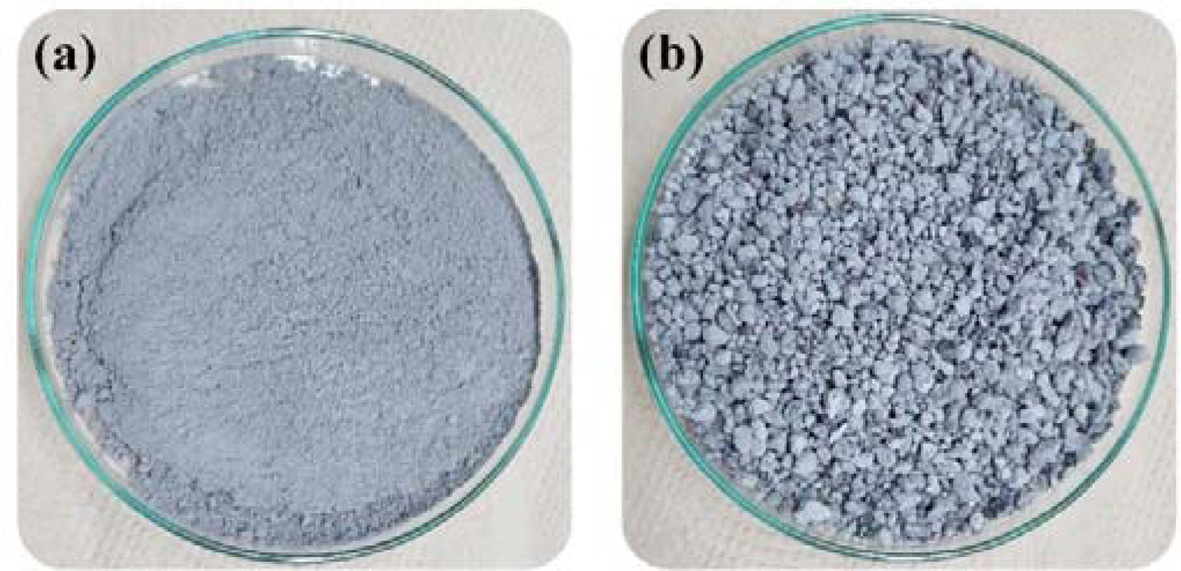
|
Fig. 1 Wheat straw ash (a) and slag aggregates (b). |
Slag aggregates were dried at a temperature of 60 ℃ in a laboratory-scale oven for 48 hrs. After drying the aggregates were immersed in sodium silicate solution under vacuum condition for 30 minutes. Vacuum condition replaces air with a silicate solution in the voids of slag aggregates. The aggregates were separated from the silicate solution after impregnation with the help of filtration and tap dried. In order to avoid the leakage of silicate solution and prevent the interaction of solution with the cementitious products, the aggregates were coated with polyvinyl alcohol (PVA) solution by spraying inside a coating machine. The details of coating machine can be found somewhere else [18]. Hot air was blown to dry the aggregate surface during the spraying process.
The mortar mixes were made with a constant water-binder ratio of 0.4 and a sand-binder ratio of 2.75 according to ASTM C109 [19]. WSA containing mixes were prepared by replacing cement with 20% of WSA. Natural sand was replaced with coated slag aggregates at replacement level of 10%, 20%, and 30% by volume. Following ASTM C109 [19] and C348 [20], mortar cubes and prisms were made. In case of prisms, two steel wires (2 mm diameter) were placed at the middle of the prism (Fig. 2) to prevent the complete breakage of the sample during the crack introduction. The samples were demolded after 24 hrs and placed in water for curing until the desire testing age.
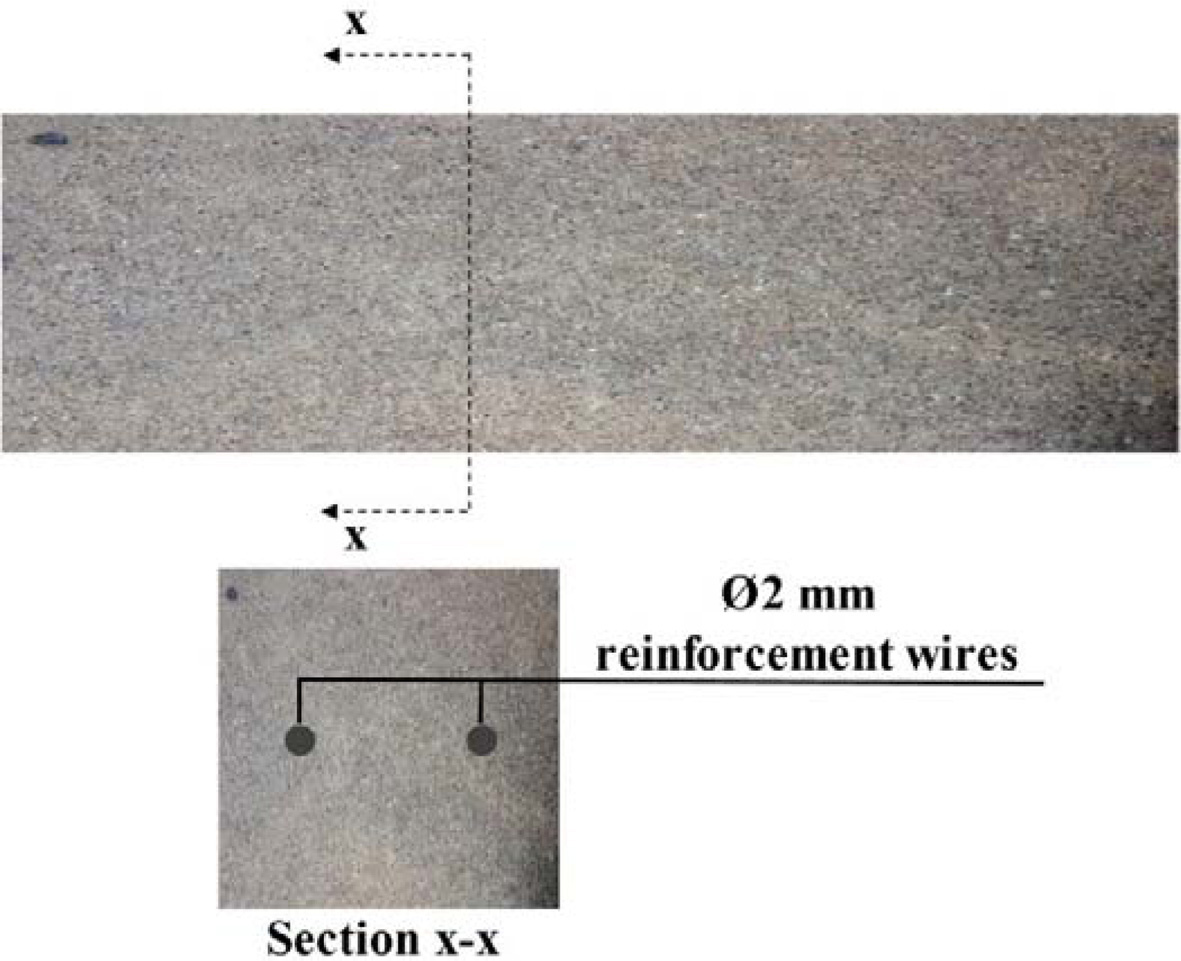
|
Fig. 2 Steel wire reinforcement details. |
Compressive strength test was employed on the cube samples after 28 days of curing in water using a universal testing machine following ASTM C109 REF [19]. Three replicates were used for each mix. The prism samples were cracked using a three-point bending machine after 28 days. After the introduction of cracks, all the samples were placed in water tank to evaluate the self-healing performance with elapsed time. Crack depths were measured using an ultrasonic pulse velocity method in accordance with ASTM C597 [21]. The procedure for the measurement of the crack depth can be found in [22, 23] and schematically shown in Figure 3. Dynamic modulus of elasticity of the mortar samples were measured according to ASTM C 215 [24]. Reference [25] contains the details of this test. Relative dynamic modulus of elasticity of the mortar samples at various ages is calculated using the equation [26];
Pc = [nc2 / n02] Χ 100 (1)
Where Pc = relative dynamic modulus of elasticity with respect to time (%),
nc = horizontal vibration frequency after the crack is introduced with respect to time,
n0 = 1st horizontal vibration before crack is introduced.
A water permeability test similar to the RILEM II.4 [27] was conducted on the mortar samples. This test has been efficiently used to investigate the crack filling ability of the cement composites [28]. Fig. 4 displays the details of the test setup. The sides of the test mold were sealed to prevent the flow of water other than the crack. The equation used to calculate the water permeability coefficient is [25];
k = (aL/At) Χ ln(h1/h2) (2)
Where k, a, A, L, T, h1, and h2 represent water permeability coefficient (cm/s), cross-sectional area of the pipette (cm2), cross-sectional area of the specimen (cm2), specimen thickness, time (s), initial water head, and final water head, respectively.
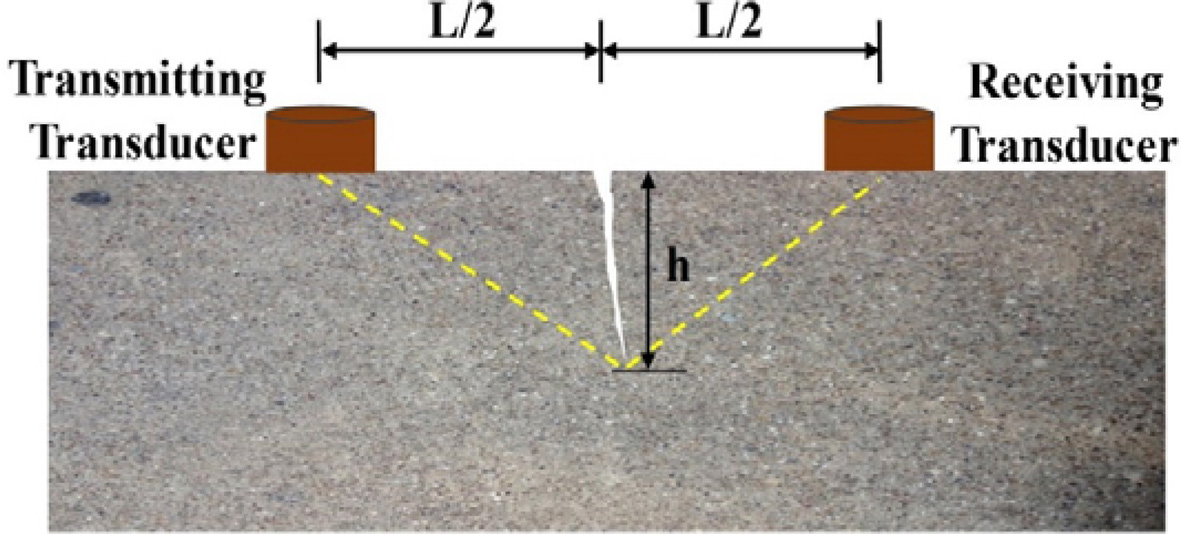
|
Fig. 3 Crack depth measurement via the ultrasonic method. |
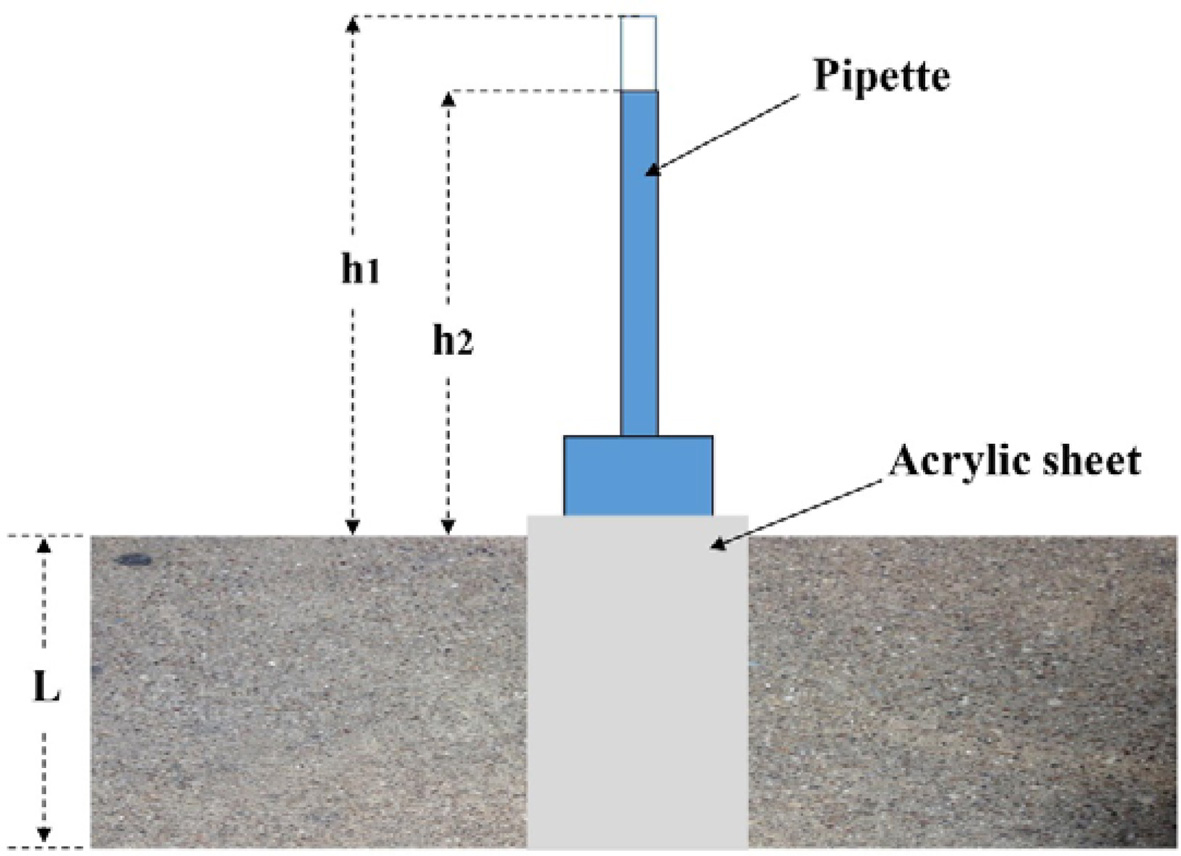
|
Fig. 4 Water permeability test setup. |
.us that compressive strength decreased with the addition of coated slag aggregates. For instance, a percentage reduction of 1.3%, 2.6%, and 5.3% in compressive strength was observed for W0S10, W0S20, and W0S30 samples, respectively in comparison with the reference sample. On the other hand, the addition of WSA resulted in an increase in compressive strength. The samples with 20% WSA and 0% slag aggregate presented an enhancement of 4.8% in compressive strength compared to the reference sample. It has been established that WSA possesses pozzolanic as well as filler effect which enhances the microstructure of cement composites resulting in an increased strength [16]. The inclusion of coated slag aggregate decreased the compressive strength as observed in the samples without WSA. A reduction of 2.1%, 2.8%, and 6.5% in compressive strength was observed for W20S10, W20S20, and W20S30 samples, respectively in comparison with W20S0 sample. The reduction in compressive strength due to the incorporation of coated slag aggregates is attributed to the weak bonding of aggregates with the cement paste [29].
Crack depth measurement via ultrasonic test
Cracks were introduced in the mortar samples and placed in water in order to observe the self-healing performance with respect to time. Ultrasonic pulse velocity test was conducted on the cracked samples to measure the depth of the crack. The time of ultrasonic waves reduces as the crack is filled with the healing products [15]. Fig. 6 depicts the crack depths in each sample with respect to time. It can be seen that all the specimens presented a decrease in crack depth with the passage of time. The crack depth for reference sample presented a decrease of 5%, 15%, and 25% at 7, 28, and 56 days, respectively compared to initial depth. This decrease is mainly due to the autogenous self-healing of cement constituents. The unhydrated cement particles in the cracks reacted in the presence of water and formed additional hydration products [30]. The samples with the coated slag aggregates presented an increased reduction in crack depths with time. For example, the crack depth for W0S10 reduced 35%, 57%, and 65% in comparison with the initial depth at 7, 28, and 56 days, respectively. At 7, 28, and 56 days, a reduction of 43%, 67%, and 86% for W0S20 sample; 54%, 79%, and 92% for W0S30 sample was observed, respectively compared to the initial crack depth. This means that sodium silicate reacted with the calcium hydroxide present in cement composite and formed addition hydration products in the crack. The samples with WSA presented an enhanced crack filling compared to the respective samples without WSA. For instance, the crack depth in W20S0 sample reduced by 21%, 32%, and 47% compared to the initial depth at 7, 28, and 56 days, respectively. A reduction in crack depth of 50%, 80%, and 95%; 50%, 88%, and 100%; 61%, 91%, and 100%, for W20S10, W20S20, and W20S30 samples, respectively was observed in comparison with the respective initial depth. The silica content in WSA reacted with the calcium hydroxide and formed additional hydration products along with the reaction of sodium silicate [16]. Fig. 5
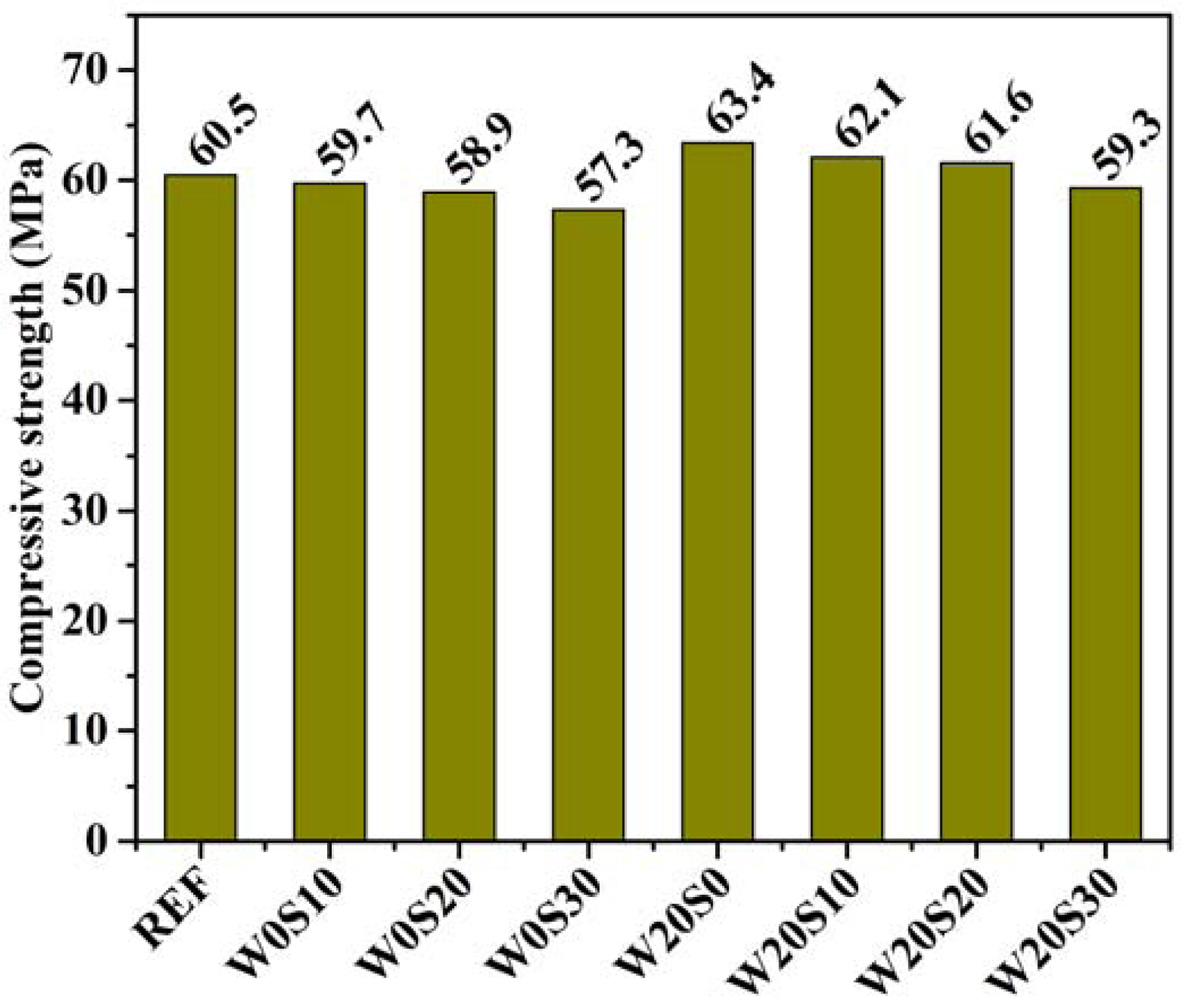
|
Fig. 5 Compressive strength of mortar samples at 28 days. |
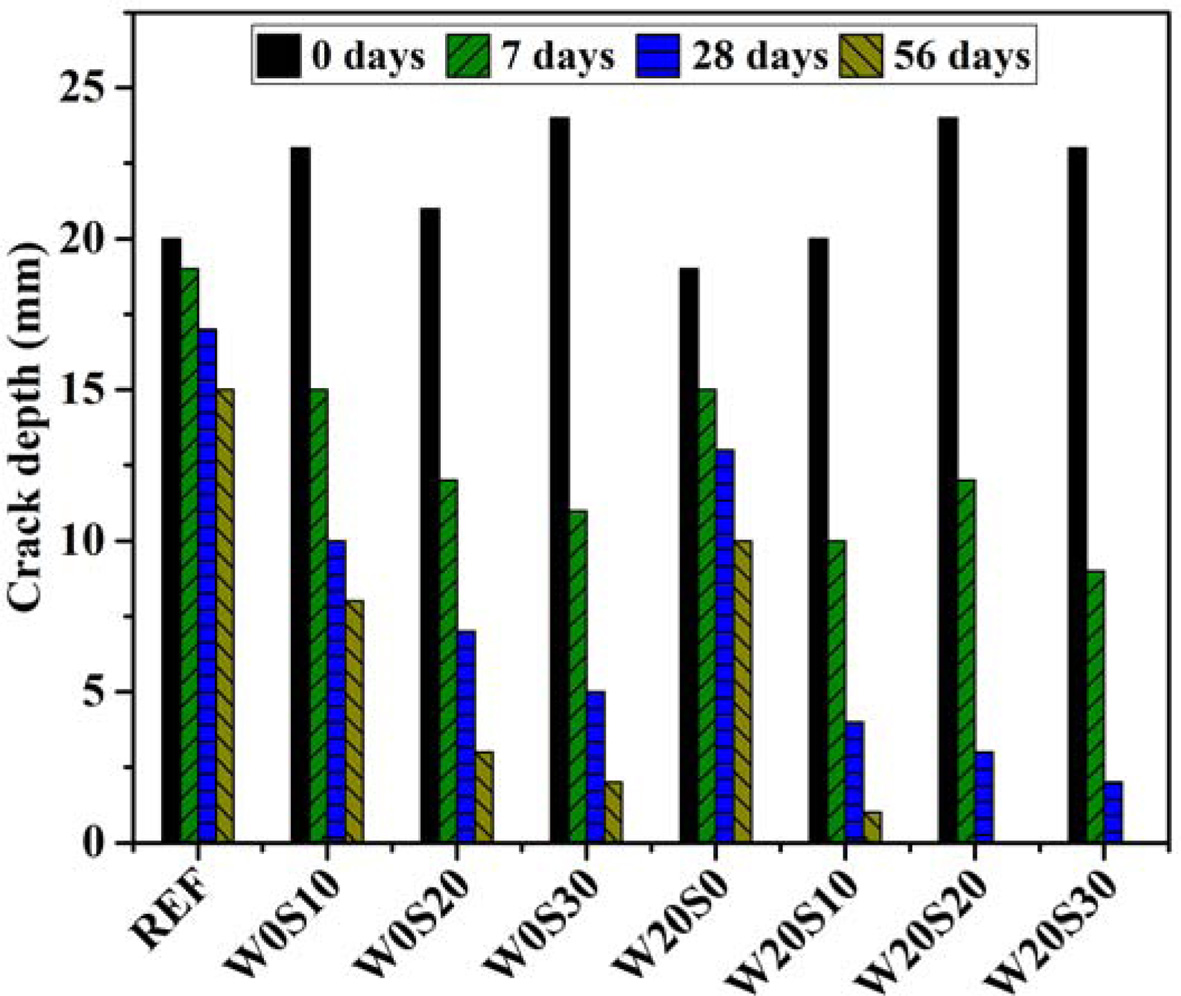
|
Fig. 6 Crack depths of mortar samples. |
Water permeability test was performed on the cracked samples to investigate the crack closing performance of the samples. Fig. 7 portrays the results of water permeability test with respect to time. The permeability of water through the crack decreased with the passage of time. The samples without coated aggregates and WSA (W0S0) presented a decrement of 2.25, 4.3%, and 8.7% in water permeability at 7, 28, and 56 days, respectively in comparison with that through the initial crack. The addition of coated aggregates caused a considerable reduction in the water permeability with the passage of time. For example, the water permeability through the crack in W0S10 sample decreased 17.6%, 33.3%, and 45.1% at 7, 28, 56 days, respectively compared to the initial crack. A percentage reduction in permeability, of 19.1%, 36.2%, and 57.4% for W0S20; 25.9%, 59.3%, and 81.5% for W0S30, was observed at 7, 28, and 56 days, respectively compared to the initial crack. The reduction in water permeability indicates the filling of cracks with the healing products formed due to the reaction of sodium silicate. The incorporation of WSA resulted in a considerable decline in the water permeability at various ages compared to that of the reference sample. For instance, W20S0 showed a decrease of 11.1%, 27.8%, and 38.9% at 7, 28, and 56 days in permeability, respectively compared to the crack at its initial state. The addition of coated slag aggregate to the WSA containing samples accelerated the formation of healing products in the cracks resulting in a decreased water permeability. For example, WSA containing samples with 10%, 20%, and 30% slag aggregate, decreased water permeability through the cracks by 10.5%, 42.1%, and 63.2%; 39.3%, 67.9%, and 96.4%; 44%, 96%, and 99.5%, at 7, 28, and 56 days, respectively. Thus, the hydration products formed due to the reaction of calcium silicate filled the cracks and reduced the permeability.
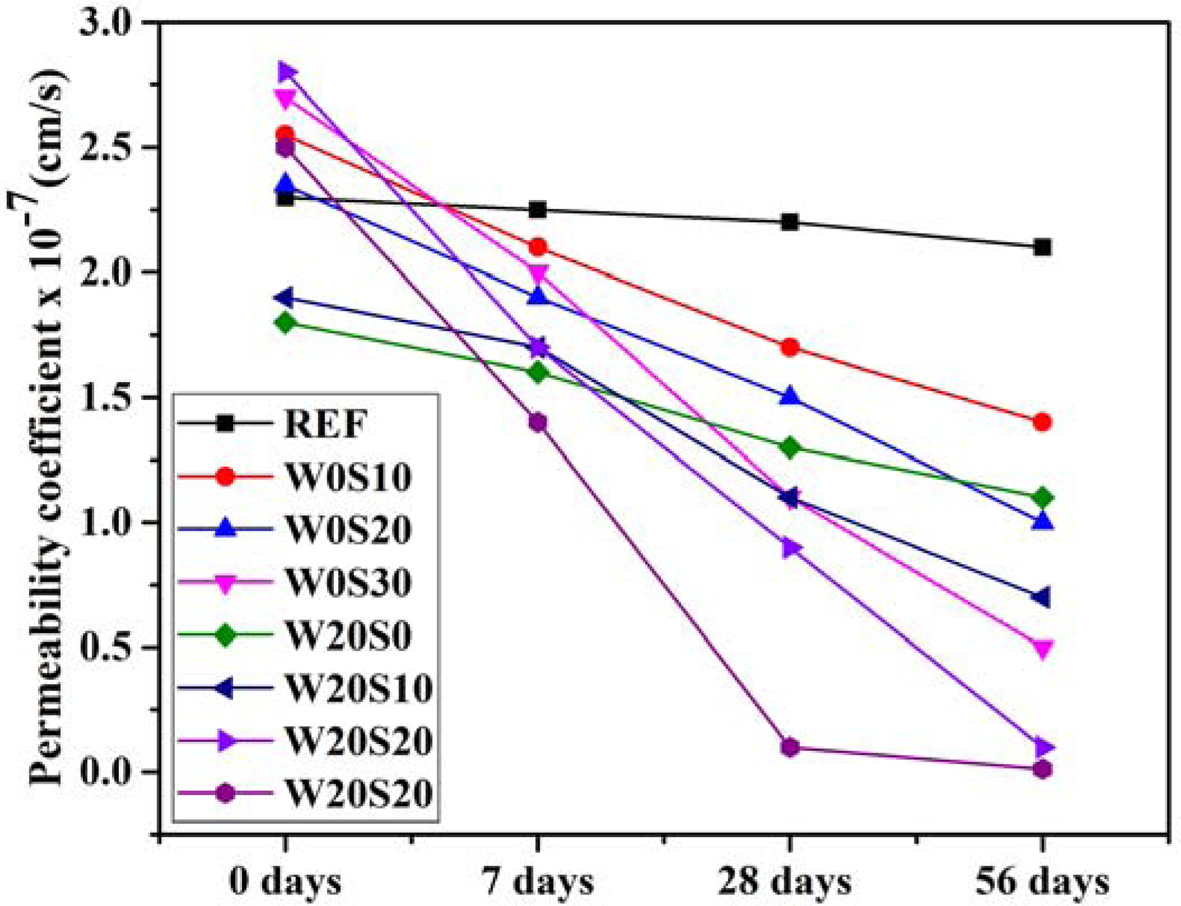
|
Fig. 7 Water permeability coefficients of mortar samples. |
Dynamic modulus of elasticity of the specimens before and after the cracks was introduced up to 56 days. Fig. 8 shows the relative dynamic modulus of elasticity of the samples with respect to time. It can be seen that dynamic modulus of elasticity decreased for all the samples with the introduction of cracks. The relative dynamic modulus of elasticity dropped by 31% for reference sample and increased by 39%, 48%, and 65% at 7, 28, and 56 days, respectively. Thus, partial filling of the cracks was achieved in case of reference samples. A drop of 35%, 30%, and 20% in relative dynamic modulus of elasticity was observed for W0S10, W0S20, and W0S30 samples, respectively, after the cracks were introduced. A considerable increase in the relative dynamic modulus of elasticity of the samples with coated slag aggregates was observed with the passage of time. For example, the samples (W0S10, W0S20, and W0S30) presented a relative dynamic modulus of 45%, 52%, and 48% at 7 days; 64%, 75%, and 80% at 28 days; 78%, 89%, and 95% at 56 days, respectively. The samples with WSA depicted a higher dynamic modulus recovery compared to the reference sample. For instance, at the age of 7, 28, and 56 days, W20S0 sample presented a relative dynamic modulus of elasticity of 46%, 59%, and 77%, respectively. The inclusion of coated slag aggregates further raised the elasticity modulus recovery. For example, W20S10 sample showed a relative dynamic modulus of elasticity of 51%, 79%, and 84% at 7, 28, and 56 days, respectively. A relative dynamic modulus of elasticity of 57% and 61% at 7 days; 88% and 91% at 28 days; 97% and 100% at 56 days was observed for W20S20 and W20S30 samples, respectively.
The results of the ultrasonic pulse velocity, water permeability, and dynamic modulus of elasticity tests clearly demonstrate that the samples with the coated slag aggregates showed a considerable crack filling ability. After the introduction of cracks, sodium silicate present in the pores of slag aggregate released and deposited inside the cracks. It further reacted with the calcium hydroxide, a cement hydration product, and formed calcium silicate hydrate (C-S-H) as follows [15];
Na2SiO3 + Ca(OH)2 → x(CaO·SiO2)·H2O + Na2O (3)
C-S-H is the main hydration product of the cement hydration which is responsible for the enhance microstructure of the cement composite [31]. Similar findings were observed in the previous studies. It has been reported that the specimens with sodium silicate as the healing agent presented a decrease of 80% in the crack depth. The decrease in crack depth occurred due to the depositions formed by the reaction of sodium silicate which ultimately resulted in a higher strength recovery [15]. The crack filling ability of the samples with the higher amount of slag aggregates i.e. 30%, was observed significantly. It may be due to the reason that more aggregate was available for the provision of the healing agent in the crack. In addition, the incorporation of WSA significantly enhanced the crack filling ability of the samples. It is mainly due to the pozzolanic reaction of WSA with the calcium hydroxide present in the cement composites [16]. The contribution of pozzolanic materials in the autogenous healing due to prolonged hydration has been reported somewhere else [32-35]. A partial filling of the cracks was also observed in the samples without WSA and slag aggregates. This may be due to the ongoing hydration of the cement particles in the presence of water [30]. Another reason for the partial crack filling of the reference samples is may be due to the formation of calcium carbonate. It has been observed that carbonation occurs when cementitious samples are exposed to air [30]. Thus, it can be concluded that the addition of slag aggregates filled with sodium silicate as healing agent along with WSA result in an enhanced self-healing performance.
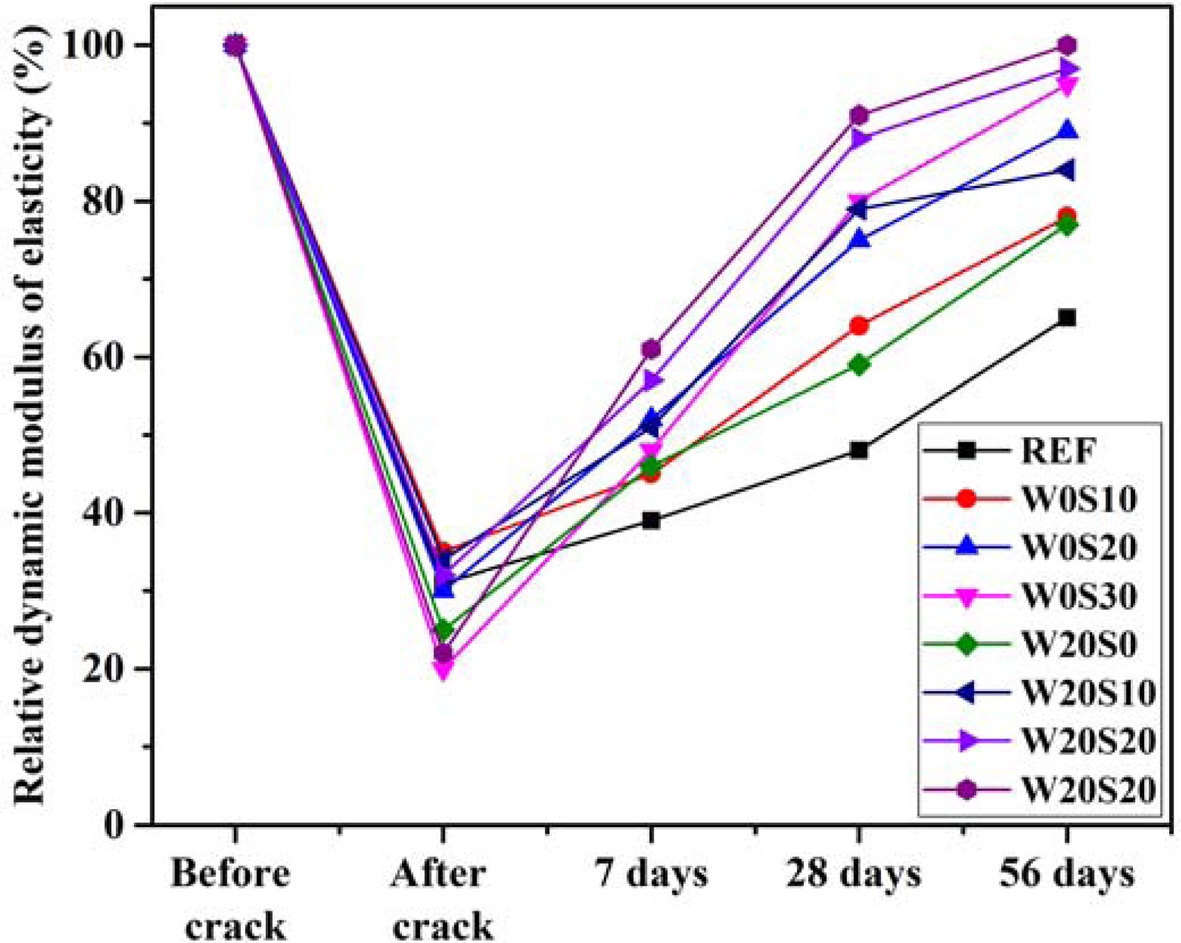
|
Fig. 8 Relative dynamic modulus of elasticity of the mortar samples. |
This study utilized coated slag aggregates impregnated with sodium silicate as healing agent in cement composites. Cement was also replaced with WSA to investigate the influence of WSA on the self-healing ability of the composites. Self-healing performance of the cement composites is measured via ultrasonic pulse velocity, water permeability, and dynamic modulus of elasticity tests. From the results, it can be concluded that the addition of coated slag aggregates resulted in a decrease in the compressive strength of the samples. However, the samples incorporated with WSA presented comparatively higher compressive strength. The samples with coated slag aggregates presented enhanced crack filling ability in comparison with the reference samples. Increasing the amount of slag aggregates resulted in an amplified crack filling ability. Additional, the inclusion of WSA caused significant increase in the self-healing performance of the cement composites.
- 1. K. Van Tittelboom, N. De Belie, Materials 6[6] (2013) 2182-2217.
-

- 2. C. Ormerod, in “Construction Statistics Annual” (Palgrave Macmillan Press 2006) p.34-49.
- 3. M. De Rooij, K. Van Tittelboom, N. De Belie, E. Schlangen, in “Self-Healing Phenomena in Cement-Based Materials: state-of-the-art report of RILEM technical committee 221-SHC: self-Healing phenomena in cement-Based materials” (Springer Press, 2013) p.9.
-

- 4. H. Huang, G. Ye, C. Qian, E. Schlangen, Mater. Des. 92 (2016) 499-511.
-

- 5. V.C. Li, E. Herbert, J. Adv. Concr. Technol. 10(6) (2012) 207-218.
-

- 6. V. Wiktor, H.M. Jonkers, Cem. Concr. Compos. 33(7) (2011) 763-770.
-

- 7. K. Sisomphon, O. Copuroglu, A. Fraaij, Heron 56[1/2] (2011) 13-32.
- 8. D.A. Morian, T. Van Dam, R. Perera, in “Use of air-cooled blast furnace slag as coarse aggregate in concrete pavements” (Federal Highway Administration Press, 2012) p.1-15.
- 9. D.M. Sadek, J. Cleaner Prod. 79 (2014) 134-141.
-

- 10. İ. Yüksel, T. Bilir, Ö. Özkan, Build. Environ. 42[7] (2007) 2651-2659.
-

- 11. J. Escalante-Garcia, R. Magallanes-Rivera, A. Gorokhovsky, Constr. Build. Mater. 23[8] (2009) 2851-2855.
-

- 12. Pelletier, M, Brown, R, Shukla, A, Bose, A. Self-healing concrete with a microencapsulated healing agent. Available online: http://energetics.chm.uri.edu/system/files/Self healing concrete -7-11.pdf [accessed on 12.11.18].
- 13. H. Huang, G. Ye, C. Leung, K. Wan, in “International RILEM conference on advances in construction materials through science and engineering” (RILEM Publications SARL, 2011) p.530-536.
- 14. E. Mostavi, S. Asadi, M.M. Hassan, M. Alansari, J. Mater. Civ. Eng. 27[12] (2015) 04015035.
-

- 15. R. Alghamri, A. Kanellopoulos, A. Al-Tabbaa, Constr. Build. Mater. 124 (2016) 910-921.
-

- 16. A. Qudoos, H.G. Kim, R. Atta ur, J.-S. Ryou, Constr. Build. Mater. 193 (2018) 481-490.
-

- 17. ASTM, ASTM C150 / C150M - 17, Standard Specification for Portland Cement, West Conshohocken, PA, 2017.
- 18. Y.-S. Lee, in “Study on crack-sealing of cement composite via encapsulating the granulated healing material, Structural engineering” (Hanyang University Press, 2015) p.42-46.
- 19. C. ASTM, 109. 2007, Standard Test Method for Compressive Strength of Hydraulic Cement Mortars (Using 2 in. or [50-mm] Cube Specimens).
- 20. C. ASTM, 348: 02, Standard test method for flexural strength of hydraulic-cement mortars (2002).
- 21. C. ASTM, 597, Standard test method for pulse velocity through concrete, ASTM International, West Conshohocken, PA (2009).
- 22. S.A. Kumar, M. Santhanam, in Proceedings of the National Seminar on Non-Destructive Evaluation, December 2006 (NDT Press, 2006) p.301.
- 23. T.R. Naik, V.M. Malhotra, J.S. Popovics, in “Handbook on nondestructive testing of concrete” (CRC Press, 2004) p.169-188.
- 24. C. ASTM, 215: 08, Standard Test Method for Fundamental Transverse, Longitudinal, and Torsional Frequencies of Concrete Specimens (2008).
- 25. Y.-S. Lee, J.-S. Ryou, Materials 9[7] (2016) 555.
-

- 26. Y.-S. Lee, J.-S. Ryou, Constr. Build. Mater. 71 (2014) 188-193.
-

- 27. RILEM II.4, Water Absorption Tube Test, (2006).
- 28. T.-H. Ahn, H.-G. Kim, J.-S. Ryou, Materials 9[8] (2016) 654.
-

- 29. H.G. Kim, A. Qudoos, J.-S. Ryou, Constr. Build. Mater. 188 (2018) 569-582.
-

- 30. C. Edvardsen, Mater. J. 196[4] (1999) 448-454.
-

- 31. H.F. Taylor, in “Cement chemistry” (Thomas Telford Press, 1997) p.113-125.
-

- 32. Ter Heide, Nynke. “Crack healing in hydrating concrete.” Delft University of Technology (2005). p.12-82.
- 33. E. Gruyaert, K. Van Tittelboom, H. Rahier, N. De Belie, in Proceedings of the 2nd International Conference on Microstructural-related Durability of Cementitious Composites, April 2012, edited by G. Ye, K.V. Breugel, W. Sun and C. Miao (RILEM Publications Press, 2012) p.1-8.
- 34. P. Termkhajornkit, T. Nawa, Y. Yamashiro, T. Saito, Cem. Concr. Compos. 31[3] (2009) 195-203.
-

- 35. D. Jaroenratanapirom, R. Sahamitmongkol, in Proceedings of the 6th annual concrete conference, January 2010 (University of MN Press, 2010) p.551-556.
 This Article
This Article
-
2019; 20(4): 314-320
Published on Aug 31, 2019
- Received on Dec 9, 2018
- Revised on Jan 15, 2019
- Accepted on Jan 15, 2019
 Services
Services
Shared
 Correspondence to
Correspondence to
- Jae-Suk Ryou
-
Department of Civil Engineering, Hanyang University, Seoul, Korea
Tel : +82-2-2220-4323 - E-mail: jsryou@hanyang.ac.kr






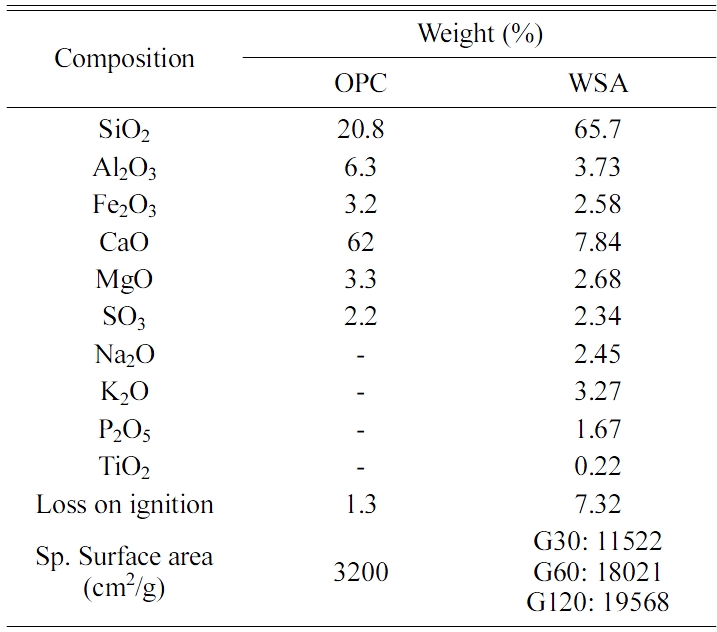
 Copyright 2019 International Orgranization for Ceramic Processing. All rights reserved.
Copyright 2019 International Orgranization for Ceramic Processing. All rights reserved.